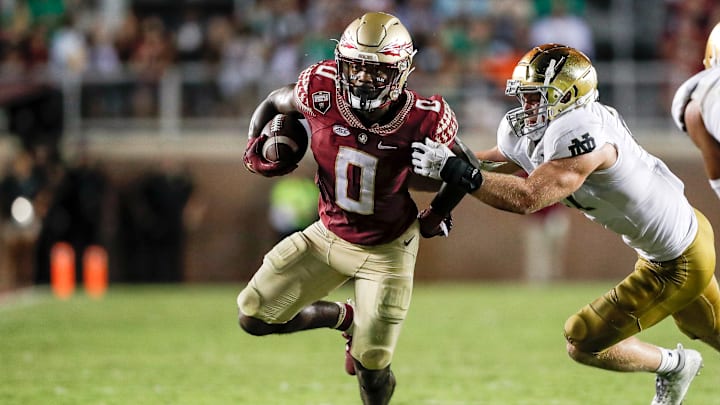Bowl Coalition and Bowl Alliance Era (1992-1997)
The Bowl Coalition lasted only three years between 1992 and 1994, but it left a lasting impression that continues to influence the modern era. Five conferences—the Big East, ACC, Southwest Conference, Big 8, and SEC—joined together along with independent powerhouse Notre Dame to forge the first attempt to systematically match No. 1 versus No. 2 in a bowl game. It worked to some extent, but controversies continue to linger around the national championship narrative.
The Coalition gave way to the Bowl Alliance in 1995, but the same issues remained in place without the Big Ten or Pac-10 as part of the group. The Alliance was already due to give way to the BCS before Michigan and Nebraska split the national championship in 1997, but that shared title reinforced the mythic nature of trying to pair the top two teams.
Had either the Bowl Coalition or the Bowl Alliance managed to get everyone on board and playingg a 12-team bracket, here are the matchups that would have stirred the public consciousness most in the opening round.
1992
#6 Michigan Wolverines (8-0-3 Big Ten champion)
vs.
#11 Nebraska Cornhuskers (9-2 Big 8 champion)
Four teams won conference championships in 1992 with undefeated records. Three of the four would have earned the top three seeds in a theoretical 12-team playoff. The fourth, Michigan, would be relegated to the 6-seed thanks to featuring three ties alongside their eight wins. They would host No. 11 Nebraska, a team ranked five seeds lower despite having more wins. This showdown of conference champs would easily dominate the news cycle in the lead-up to the Saturday of the opening round.
1993
#8 Florida Gators (10-2 SEC champion)
vs.
#9 Miami Hurricanes (9-2 Big East runner-up)
Few things (if anything) are more thrilling in college football than rivalry games. These games become even more exciting when the stakes ramp up for both sides. Imagine a Miami team still at the height of its significance as a nouveau riche titan under Dennis Erickson traveling to Gainesville to square off against Steve Spurrier's Gators for a chance to take on Nebraska in the next round. Dan Patrick's head might have exploded Scanners-style on air during SportsCenter in the week before the game.
1994
#5 Colorado Buffaloes (10-1 Big 8 runner-up)
vs.
#12 Utah Utes (9-2 WAC runner-up)
One of the most striking aspects of college football history is the relative absence of an entire time zone in the national championship narrative. The 1994 season was Bill McCartney's last as the head coach at Colorado, and the only blemish on an otherwise perfect record was a late October defeat at Nebraska. Despite featuring as the flagship state universities of neighboring states, Colorado hadn't played WAC power Utah since 1962. This rare matchup (before they both joined the Pac-12 in the 2010s) would have been epically hyped.
1995
#8 Notre Dame Fighting Irish (9-2 independent)
vs.
#9 Florida State Seminoles (9-2 ACC co-champion)
These two schools met in real life at the Orange Bowl on New Year's Day 1996, with ACC co-champion Florida State prevailing 31-26 in an instant classic that alternating lead changes at the end of every quarter and a pair of wide receivers from opposing teams sharing the MVP spoils. Now imagine if that same game had featured as the crown jewel of an opening round, with the winner getting a shot at top-ranked Nebraska.
1996
#5 BYU Cougars (13-1 WAC champion)
vs.
#12 Washington Huskies (9-2 Pac-10 runner-up)
Despite becoming the first team to win 13 game in the regular season since Yale went 13-1 a century earlier, BYU was left out of the Bowl Alliance picture in 1996. The Cougars would have been the 5-seed in a theoretical playoff date against Pac-10 runner-up Washington in Provo. The 1984 national champion, shut out of a chance at another title in real life, would have had a legitimate pathway to a second crown in 12 years.
1997
#8 Washington State Cougars (10-1 Pac-10 co-champion)
vs.
#9 Kansas State Wildcats (10-1 Big 12 North runner-up)
In the last year before the BCS era launched, the best playoff matchup of the opening round would undoubtedly be the one pitting a pair of 10-win schools against one another. Washington State and UCLA shared the Pac-10 title in 1997, with the Bruins earning the Rose Bowl nod. The Cougars, led by standout quarterback Ryan Leaf, would square off against a Kansas State team whose only loss of the year came against Big 12 champion Nebraska. Both teams would enter this game with huge chips on their shoulders.
